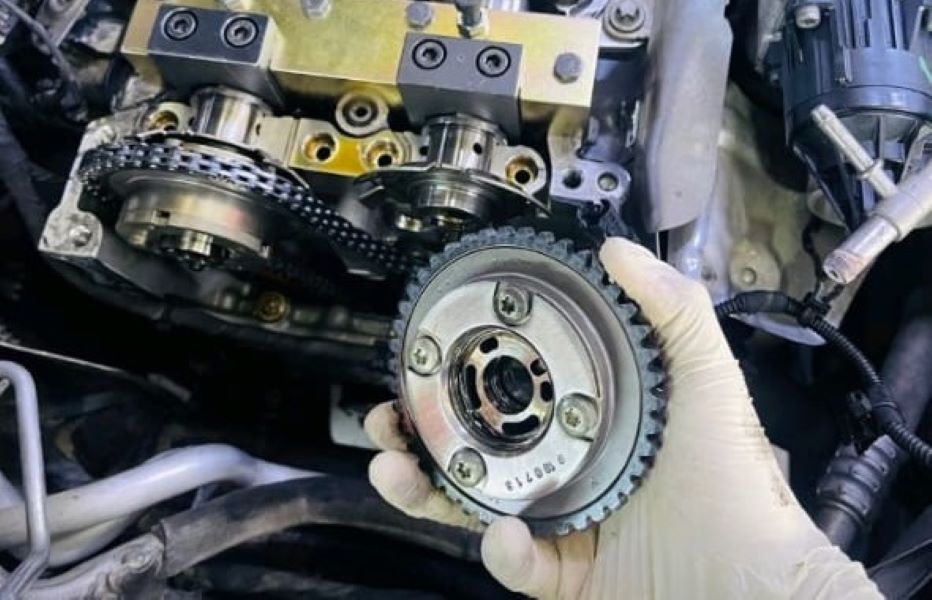Table of Contents
Car Will Turn But Not Start: Mercedes-Benz A-Class W177 ; Timing Fault Case Study
When a Mercedes-Benz A Class W177 turns over but won’t start, the culprits often hide in timing control, sensor signals, or fuel/ignition delivery. This real workshop case shows how an exhaust camshaft + camshaft adjuster fault on the M260 Engine created a no-start despite good cranking and how a structured diagnosis led to a clean fix.
Vehicle & Complaint
- Model: Mercedes-Benz A-Class W177
- Engine: M260
- Customer complaint: “Car will turn but not start.”

Diagnostic Path (Step-by-Step)
1. Short Test & DTCs
- – Faults logged for exhaust camshaft position → points to timing/VVT control or signal integrity.
2. Power & Ground to Sensor
- – Exhaust camshaft position sensor power supply: OK
- – Grounds: OK → sensor is powered correctly.
3. Signal Integrity
- – Sensor signal abnormal/unstable during crank.
- – Note: Bad timing can make a good sensor look bad.

4. Wiring & Resistance Checks
- – Harness continuity/resistance within spec → wiring not the root cause.
5. Mechanical Timing Verification
- – Opened for inspection.
- – Finding: Misalignment between exhaust camshaft and exhaust camshaft adjuster (phaser).
- – Result: ECU can’t reconcile crank/cam correlation → no start even with healthy cranking.



Root Cause
Mechanical misalignment/failure of the exhaust camshaft & exhaust adjuster (VVT phaser) on the M260 disrupting cam/crank sync and preventing start authorization/fuel timing.


Repair Procedure
Replaced:
- – Exhaust camshaft (OEM)
- – Exhaust camshaft adjuster/phaser (OEM)
Reassembly & Setup:
- – Set timing using WIS alignment references.
- – Verified chain tension and timing marks.
- – Cleared DTCs and performed cam/idle adaptations.
Post-repair tests:
- – Crank → Immediate start
- – No DTCs returned
- – Stable cam actual vs. specified positions on live data

Quick Reference Tables
Symptoms → Likely Causes
| Symptom | Likely Cause |
|---|---|
| Cranks, won’t start | Cam/crank correlation off (timing/phaser) |
| DTCs for cam position | Sensor signal skewed by mechanical misalignment |
| Intermittent sync during crank | Sticking/failed cam phaser or worn sprocket |
What We Tested
| Test | Result | Meaning |
|---|---|---|
| Sensor power/ground | OK | Sensor powered; look at signal/mechanics |
| Signal waveform | Unstable | Correlation problem likely |
| Harness continuity | OK | Not a wiring fault |
| Mechanical timing | Off | Root cause confirmed |
Camshaft Adjusters (Phasers) : Fast Primer
- – Role: Advance/retard cam timing (VVT) for power, economy, emissions.
- – How: Hydraulic (oil-pressure) phaser controlled by ECU via solenoid; feedback via cam sensor.
- – Failure modes: Wear, internal sticking, oil sludge, solenoid faults → timing misalignment, no start, misfires.
Prevention:
- – Use MB-approved oil, change on time, keep oil passages clean; inspect/replace phaser if adaptation values drift.
Camshaft Position Sensor ; Location & Notes (General)
- – Typically on the cylinder head near the cam; varies by engine (front/side/rear).
- – A failed sensor can cause hard/no-start, but mechanical mis-timing can mimic sensor failure.
Takeaways
- – Don’t stop at a sensor DTC validate mechanical timing when the engine cranks but won’t start.
- – Power/ground OK + bad signal = suspect timing/phaser, not just the sensor.
- – Always finish with adaptations and a correlation check in live data.
Prevention & Maintenance
| Action | Why it Helps |
|---|---|
| Follow MB oil spec & intervals | Keeps VVT hydraulics clean and responsive |
| Inspect timing marks if correlation DTCs repeat | Catches early phaser/chain issues |
| Replace filters with OEM | Ensures correct oil flow/pressure to phasers |
| Record live data baselines | Early detection of drift in cam actual vs. specified |
Related Diagnostic Resource
If your Mercedes is showing electrical warnings or struggling to start, explore our complete troubleshooting guides:
Mercedes Electrical Problems: Fix SAM, ECU & CAN Bus Faults; learn how to diagnose power loss, short circuits, and communication errors in control modules and wiring systems.
Mercedes No Start Issues: Causes, Fixes & Case Studies; a comprehensive guide covering electrical, fuel, and ECU-related no-start scenarios across multiple Mercedes models.
Together, these resources give you a complete diagnostic roadmap from electrical supply faults and ECU power interruptions to full no-start and communication-related issues.
FAQ
Q1: Why does the car crank but not start if the sensor has power?
Because the mechanical timing can be off so the ECU sees invalid cam/crank correlation and withholds start.
Q2: Can a bad camshaft adjuster alone cause a no-start?
Yes. A stuck or misindexed phaser can push timing far enough out to prevent combustion during crank.
Q3: Should I replace the cam sensor first?
Not before confirming timing alignment. Replace the sensor only if power/ground/signals remain faulty with verified timing.
Author Bio
Written by Mercedes Expert
With years of hands-on experience diagnosing and repairing Mercedes-Benz systems, he brings technical depth and practical case studies to help car owners, technicians, and enthusiasts troubleshoot complex automotive issues. His work focuses on clear repair guides, OEM-level procedures, and knowledge-sharing to empower both professionals and drivers.
Last update: November 2025






Leave a Reply